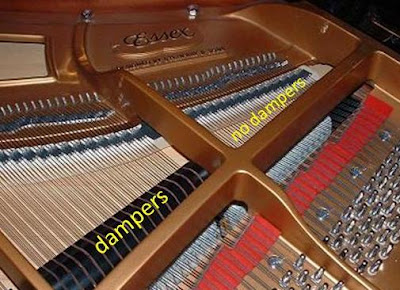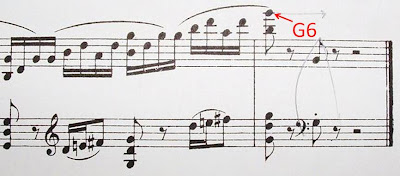I've played a lot of pianos. But it never occurred to me to think much about how many dampers there are.
Dampers are felt-bottomed wooden blocks that lift off a key's strings when the key is depressed, allowing the strings to vibrate. The damper then drops back on to the strings when the key is released, stopping the strings from vibrating. Each key on the piano has a damper, except for the highest few keys. I always assumed the highest keys didn't have dampers because their sustain wouldn't interfere unpleasantly with the music (either because they have less sustain or for some psycho-acoustic reason, dunno).
But I never noticed where the dampers stopped until I got my own piano. My Essex EGP-183 has 71 dampers. That means the last damper is on the G6 key. I noticed that some of my pieces sounded a little funny in the upper register. So I started looking at the other pianos I play. The nine-foot Steinway D has 71 dampers. But all of the other Steinway grands I play (M, L and B models) have 67 dampers (ending at D#6). And all the Yamaha grands I know have 69 dampers (ending at F6).
So what difference does it make?
Turns out I play two pieces that have passages that climb up to exactly G6 and stop there, followed by rests. On most pianos, that means the G rings out over the rests. But on my Essex, the G stops dead.
Luckily, it's easy to hold the G6 with the right hand pinky and come off the other right hand notes dry. And I really prefer the sound (probably because I played the Ginastera for many years on pianos with no G6 damper and I'm used to that sound).
The Rachmaninoff is a different story: I've only ever played it on my Essex. But that ending sounds really dry to me. If I hold the G6 with the pinky and take both the G3 and G4 in the left hand, it sounds "right" to me. (In most recordings, the room is live enough that the note sustains, damper or not).
So how's that for minutia?
Tuesday, July 28, 2009
Subscribe to:
Comments (Atom)







